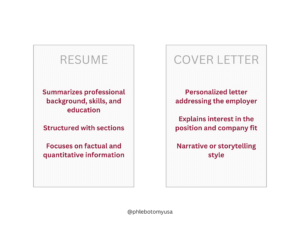27 Nov Drawing Attention With the Perfect Phlebotomy Resume
To secure a phlebotomy job, a cover letter and resume that will capture the attention of potential employers is essential. These documents are your first opportunity to make a strong impression and showcase your skills and experience. Knowing how to craft a standout resume and cover letter can significantly increase your chances of landing your dream phlebotomy job.
Understanding the Importance of a Cover Letter and Resume
When applying for a phlebotomy position, your cover letter and resume serve different purposes but are equally important. The cover letter introduces yourself to the hiring manager and explains why you are the right candidate. It allows you to show enthusiasm and highlight qualifications that make you stand out.
Your resume, on the other hand, provides a comprehensive summary of your skills, education, experience, and certifications. It is a way for the hiring manager to quickly determine if you are a good fit for the role.
The Role of a Cover Letter in Job Applications
A well-written cover letter can make a significant impact on your job application. It lets you showcase your personality and explain your interest in the phlebotomy position. Use the cover letter to emphasize your passion for phlebotomy and desire to contribute to the healthcare industry. Personalize each cover letter by addressing it to the hiring manager by name if possible. Likewise, tailor the content to match the job requirements.
Additionally, a cover letter highlights relevant experiences or skills that may not be immediately apparent on your resume. For example, if you have volunteered at a blood drive, you can use the cover letter to explain how these experiences have prepared you for a phlebotomy career.
Furthermore, a cover letter allows you to address any potential gaps in your resume or provide explanations for career changes. You can use it to provide context and reassure the hiring manager of your commitment to the position.
Why Your Resume Matters in Phlebotomy Jobs
Your resume is a snapshot of your professional history and qualifications. A well-structured and organized resume can make all the difference in phlebotomy, where precision and attention to detail are crucial. Include relevant work experience, internships, and any specialized training or certifications you have obtained.
When crafting your resume, consider including a section highlighting your technical skills in phlebotomy. This can include proficiency in venipuncture techniques, knowledge of different blood collection methods, and familiarity with laboratory equipment. You demonstrate to the hiring manager that you have the skills to excel in a phlebotomy role by showcasing your expertise.
In addition to technical skills, you must highlight leadership roles or additional responsibilities you have taken on. This will demonstrate your ability to excel in a fast-paced environment and your potential as a valuable team member. For example, if you have supervised other phlebotomists or have been responsible for managing supplies, include these details in your resume.
Lastly, don’t forget to include affiliations with relevant organizations, such as the American Society of Phlebotomy Technicians. This shows your commitment to staying current in the field and your dedication to providing quality care to patients.
Critical Elements of a Successful Cover Letter
A cover letter is an essential part of the job application process. It allows you to introduce yourself to potential employers and showcase your qualifications and enthusiasm for the position. While many elements make a successful cover letter, there are a few key aspects that you should pay attention to.
Addressing the Hiring Manager
One of the first things you should do when writing a cover letter is to address the hiring manager directly. This shows that you have taken the time to research and find out who will be reading your application. Instead of generic salutations like “To Whom It May Concern,” try to find the hiring manager’s name. Personalizing your cover letter demonstrates your attention to detail and genuine interest in the position.
For example, if the hiring manager’s name is John Smith, you could start your cover letter with “Dear Mr. Smith” or “Dear John.”
Highlighting Your Skills and Experience
Another vital element of a successful cover letter is highlighting your relevant skills and experience. Take the time to carefully review the job description and identify the key qualifications that the employer is looking for. Then, tailor your cover letter to showcase how your skills and experience align with those requirements.
You might want to emphasize your ability to handle challenging situations, attention to detail, and communication skills for a phlebotomy job. Provide specific examples of how you have demonstrated these skills in previous roles. This could be successfully calming anxious patients or accurately labeling and documenting blood samples. You will stand out as a strong candidate for the position by showcasing your relevant qualifications.
Showcasing Your Passion for Phlebotomy
In addition to highlighting your experience, showcasing your passion for phlebotomy in your cover letter is essential. Explain why you are drawn to the profession and how it aligns with your career goals. Share any personal experiences or stories that have influenced your decision to pursue a career in phlebotomy.
For instance, you could talk about how you are fascinated by the medical field and strongly desire to help others. You could also mention any experiences you have had, such as volunteering at a blood drive or shadowing a phlebotomist, that have solidified your passion for the field. By expressing your genuine interest, you will demonstrate to the employer that you are dedicated to a career in phlebotomy.
In conclusion, a successful cover letter should address the hiring manager directly, highlight your relevant skills and experience, and showcase your passion for the position. Attention to these critical elements will increase your chances of standing out among other applicants and securing the job.
Building a Strong Resume for a Phlebotomy Position
Structuring Your Resume Effectively
When structuring your resume, make sure to organize it in a way that is easy to read and navigate. Use clear headings and bullet points to separate different sections. Start with a summary statement that highlights your key qualifications and objectives. Follow this with sections for education, work experience, certifications, and additional skills or relevant training.
Detailing Your Phlebotomy Experience
In the work experience section of your resume, provide detailed information about your phlebotomy experience. Include the names of the organizations you have worked for, the length of your employment, and a description of your responsibilities and accomplishments. Highlight any specific achievements or recognition you have received concerning your phlebotomy work.
Including Relevant Certifications and Training
In the field of phlebotomy, certifications and specialized training are highly valued. Include any relevant certifications you have obtained, such as Certified Phlebotomy Technician (CPT) or Certified Medical Assistant (CMA). Mention any additional courses or training programs you have completed that are related to phlebotomy. These certifications and training programs demonstrate your dedication to staying current in the field and expanding your knowledge and skills.
Common Mistakes to Avoid in Your Application
Generic Cover Letters and Resumes
Avoid using generic cover letters and resumes that lack personalization. Tailor each application to the specific job and employer. Take the time to research the organization and understand its values and mission. Incorporate this knowledge into your cover letter and resume to show your interest in the role and company.
Neglecting to Proofread
One common mistake that can immediately sabotage your application is neglecting to proofread your cover letter and resume. Spelling and grammar mistakes can make you appear careless and unprofessional. Take the time to thoroughly review your documents for errors and ensure they are error-free before submitting them.
Overlooking the Job Description
Read the job description carefully and ensure your cover letter and resume address the requirements and qualifications mentioned. Tailor your application to match the position’s needs and highlight how your skills align with the job requirements. This will show that you have taken the time to understand the role and are genuinely interested in the opportunity.
By crafting a compelling cover letter and resume, you can significantly increase your chances of standing out among other applicants. Use these documents to showcase your skills, experience, and passion for the field. Demonstrate why you are the perfect fit for the position. Remember to tailor each application to the job and employer, and proofread your documents thoroughly before submitting them. With a well-crafted cover letter and resume, you can land your dream phlebotomy job.


